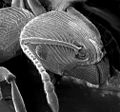 | A protist (/ˈproʊtɪst/ PROH-tist) or protoctist is any eukaryotic organism that is not an animal, land plant, or fungus. Protists do not form a natural... 94 KB (9,774 words) - 16:29, 6 May 2024 |
 | Marine protists Marine protists are defined by their habitat as protists that live in marine environments, that is, in the saltwater of seas or oceans... 131 KB (10,542 words) - 04:29, 6 January 2024 |
 | Exoskeleton (redirect from Animal shell) tardigrades, as well as the outer shell of certain sponges and the mollusc shell shared by snails, clams, tusk shells, chitons and nautilus. Some vertebrate... 18 KB (2,118 words) - 17:48, 24 April 2024 |
 | sea shell, also known simply as a shell, is a hard, protective outer layer usually created by an animal or organism that lives in the sea. The shell is... 39 KB (4,747 words) - 23:18, 19 April 2024 |
 | Nacre (redirect from Pearl shell) organic–inorganic composite material produced by some molluscs as an inner shell layer. It is also the material of which pearls are composed. It is strong... 36 KB (3,894 words) - 03:30, 25 February 2024 |
 | Test (biology) (redirect from Test (shell)) In biology, a test is the hard shell of some spherical marine animals and protists, notably sea urchins and microorganisms such as testate foraminiferans... 6 KB (656 words) - 13:28, 30 September 2023 |
 | in biological systems, such as the formation of stromatolites or mollusc shells (see Biomineralization). Calcification can manifest itself in many ways... 9 KB (884 words) - 00:59, 26 November 2023 |
 | as cuttlefish bone, is a hard, brittle internal structure (an internal shell) found in all members of the family Sepiidae, commonly known as cuttlefish... 16 KB (1,637 words) - 07:31, 10 May 2024 |
 | (shells) Arthropod exoskeleton cuticle Brachiopod shell Cephalopod shell cirrate shell cuttlebone gladius Lorica Choanoflagellate lorica Protist shell... 10 KB (1,159 words) - 04:19, 15 April 2024 |
 | and cuttlefish) have an internalized vestigial aragonite/calcite-chitin shell known as gladius or cuttlebone, which can serve as muscle attachments but... 5 KB (569 words) - 03:06, 24 April 2024 |
 | (shells) Arthropod exoskeleton cuticle Brachiopod shell Cephalopod shell cirrate shell cuttlebone gladius Lorica Choanoflagellate lorica Protist shell... 19 KB (2,141 words) - 22:30, 27 December 2023 |
 | Coccolithophore (section Coccolithophore shells) predator to utilise the organic content of coccolithophores. Heterotrophic protists are able to selectively choose prey on the basis of its size or shape and... 90 KB (9,304 words) - 21:13, 2 January 2024 |
 | (shells) Arthropod exoskeleton cuticle Brachiopod shell Cephalopod shell cirrate shell cuttlebone gladius Lorica Choanoflagellate lorica Protist shell... 6 KB (708 words) - 05:25, 12 May 2023 |
 | (shells) Arthropod exoskeleton cuticle Brachiopod shell Cephalopod shell cirrate shell cuttlebone gladius Lorica Choanoflagellate lorica Protist shell... 8 KB (943 words) - 19:49, 4 October 2023 |
(shells) Arthropod exoskeleton cuticle Brachiopod shell Cephalopod shell cirrate shell cuttlebone gladius Lorica Choanoflagellate lorica Protist shell... 17 KB (1,907 words) - 07:53, 24 August 2023 |
 | Mineralized tissues (section Mollusk shell) these tissues form a protective shield or structural support. Bone, mollusc shells, deep sea sponge Euplectella species, radiolarians, diatoms, antler bone... 41 KB (4,753 words) - 14:46, 21 December 2023 |
Small shelly fauna (section Minerals used in shells) shells. These animals may have been molluscs or worm-like Sipuncula. Other molluscan univalved shells have been found in Canada. Some bivalve shells have... 40 KB (4,941 words) - 19:09, 1 April 2024 |
 | In biology, a lorica is a shell-like protective outer covering, often reinforced with sand grains and other particles that some protozoans and loriciferan... 2 KB (226 words) - 14:32, 16 August 2023 |









